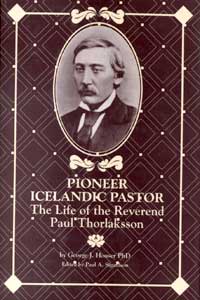Pioneer Icelandic Pastor:
The Life of the Reverend Paul Thorlaksson
George J. Houser, PhD
Edited by Paul A. Sigurdson
Manitoba Historical Society, 1990
ISBN 0-921950-07-1
Preface:
Among the names of Icelandic pioneers in North America, one of the most familiar is that of the Reverend Paul Thorlaksson, who died at Mountain, North Dakota on March 12, 1882 in his thirty-third year. Born in Iceland in 1849, Paul Thorlaksson emigrated to America in 1872 at the age of twenty-two. In the ten years before his untimely death from pulmonary tuberculosis, he became one of the most widely discussed and controversial figures among the Icelandic settlers in the United States and Canada. This reputation is all the more unusual in view of the fact that for the first three yeras in America he was still a theological student, while during the final year of his life he was bedfast most of the time.
Paul had the clarity of vision to recognize that the preservation of the finest elements of Icelandic culture would be enhanced rather than diminished through contact with people from other countries who could teach the Icelanders the skills and techniques they had to acquire before they could prosper here. He envisioned more clearly than anyone else the legacy of Icelandic prosperity in America, and the potential prosperity of all Icelanders on this continent.
Ironically, however, there was a persistent tendency to associate Paul's name primarily with the so-called "religious controversy" at New Iceland rather than with the qualities of leadership he displayed and his outstanding accomplishments.
Harshly criticized in print by some of his contemporaries, by others Paul was gratefully remembered as the compassionate and indomitable "Father of the Icelandic Settlement in North Dakota."
Most of the primary source material about the early Icelandic experience in North America consists of official documents, records and annals. The raw material of biography after the passage of 100 years is, however, more elusive and considerably less objective. It consists largely of letters, diaries, reminiscences and contemporary newspaper clippings, most of which were based on personal reactions rather than objective reporting. In the case of Paul Thorlaksson, who from 1875 until 1882 was an ordained Lutheran minister, his own pastoral records also constitute an essential source. A school copybook with some of these records came to light only recently in a trunk in the attic of a house in North Dakota. The remainder of the material has been gathered from the Public Archives of Canada, Special Collections of the Elizabeth Dafoe Library of the University of Manitoba, private collections in Canada, the United States and Iceland, the National Archives of Iceland and the manuscript collection of the National Library in Reykjavik.
Because most of the material was written in the Icelandic language, direct translation by the writer accounts for a large part of this work.
The wide dispersion of the primary source material, as well as its inaccessibility to researchers with no knowledge of Icelandic, has been largely responsible for the misunderstanding of Paul and his motives. The final, authoritative word on most subjects has yet to be written, and such is no doubt the case with the life and career of Paul Thorlaksson. Should some future historian or biographer uncover additional information, the writer would be only too pleased.
It is to be hoped, however, that the present work will cast light on aspects of Paul Thorlaksson's career that up to now have not been accorded the attention they merit. In this way, perhaps, one can best honour the memory of a remarkable man on the centenary of his death.
George J. Houser, PhD
March 1982
Winnipeg, Manitoba
|
